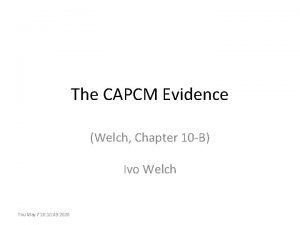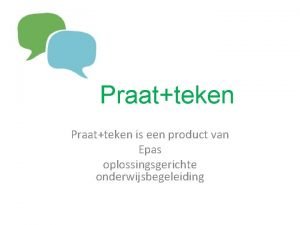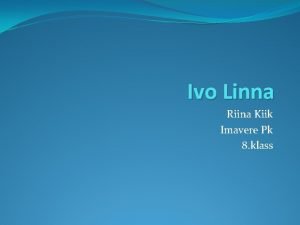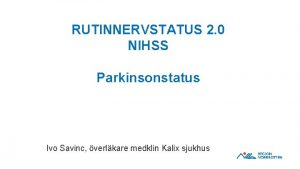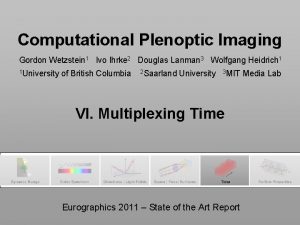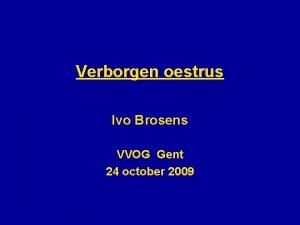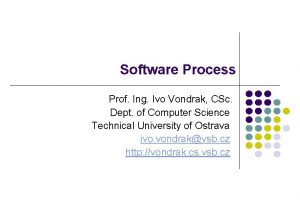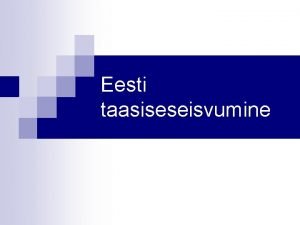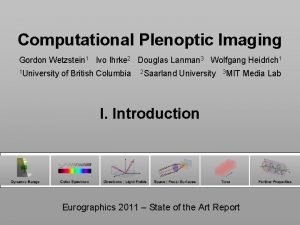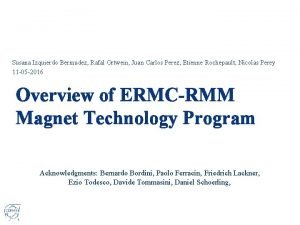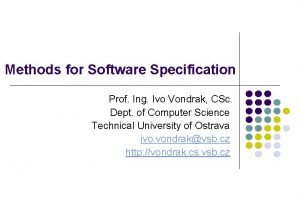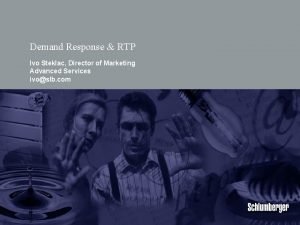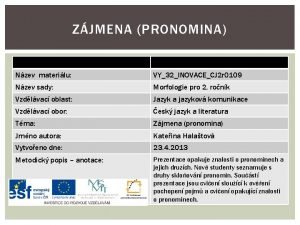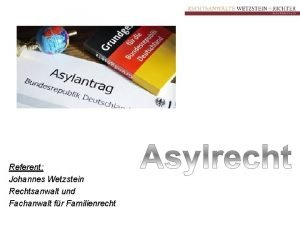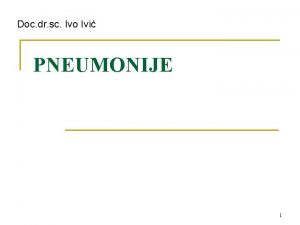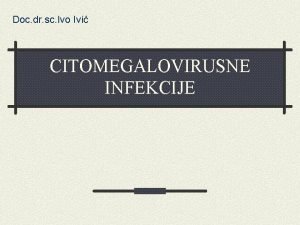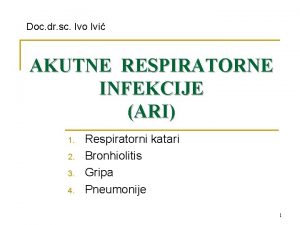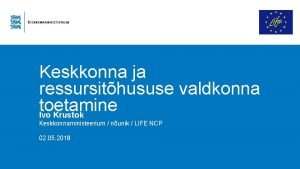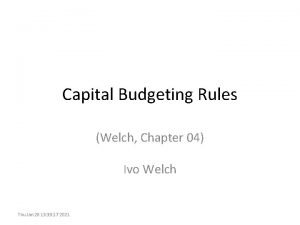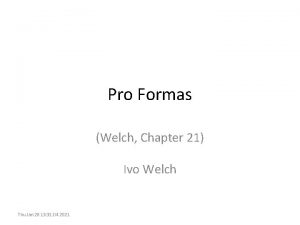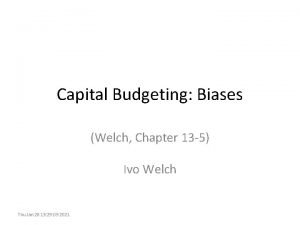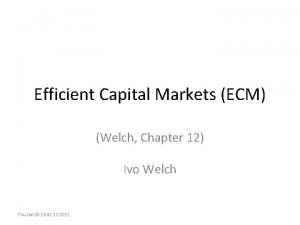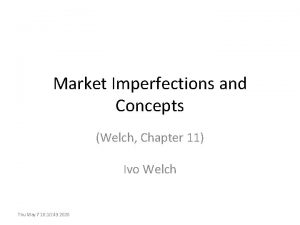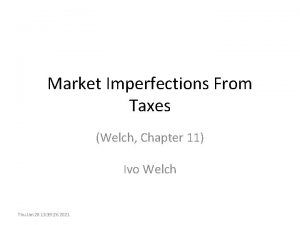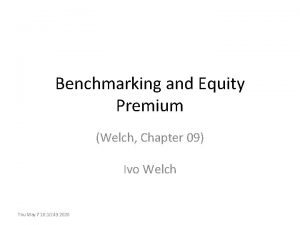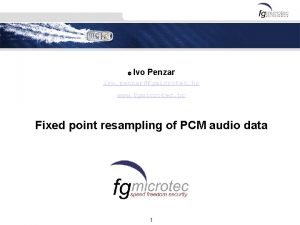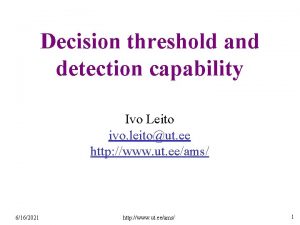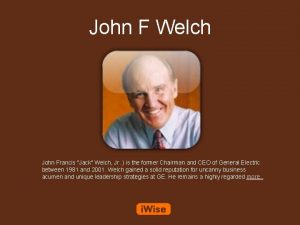The CAPCM Welch Chapter 10 A Ivo Welch

























































- Slides: 57

The CAPCM (Welch, Chapter 10 -A) Ivo Welch Thu Jan 28 13: 28: 40 2021

1: Maintained Assumptions Perfect Markets 1. No differences in opinion. 2. No taxes. 3. No transaction costs. 4. No big sellers/buyers—infinitely many clones that can buy or sell. With risk and specific risk aversion – this chapter leans more heavily on its assumptions than the benchmarking chapter!

2: Same Question Again!

3: With Stronger Assumptions No measurement or model error. Investors dislike risk, they are smart, etc. , care about default, term, and equity risk. Investors care only about pfio risk and reward, and risk is just SD, and investors hold mostly the market pfio, and all risk is alike. – same for oil and real-estate as for Treasuries

4: What Is Assumed Away? Anything not in PFM (i. e. , in ICM). No unique labor or asset ownership. No state-dependent preferences. No uncertainty about inputs. Careless or Stupid Investors.

5: Project-Beta Premium?

6: Project-Variance Premium? Do projects that have high variance, but whose risk can be diversified away in our portfolio, need to provide more reward?

7: The CAPCM Formula

8: Beta of Zero

9: Beta of One

10: Intercept and Slope?

11: The CAPCM Formula. I

12: The CAPCM Formula II

13: The CAPCM Ingredients The three most important numbers in finance are the inputs: – the risk-free Ro. R, – the equity premium, – and the risk-hedging capability of the project.

14: CAPCM Inputs Importance In what other contexts might you care about the three CAPCM inputs?

15: If the CAPCM Works All CAPCM project valuation is relative to (your estimate of) the equity premium. – If the risk-free rate and equity premium pin down risk-reward relationships in the economy, then – beta—and beta only—matters. – nothing else, like book-value, size, momentum, etc. , can matter.

16: CAPCM Inputs

17: Intercept and Slope Signs?

18: Beta vs Ro. R

19: Graph: Beta Exposition beta

20: Negative Expected Returns? If the risk-free rate is positive, would you ever buy a stock with a negative expected return?

21: Zero-Beta vs Risk-Free Rate? Why is there no difference between a zero-beta risky project and the risk-free rate when it comes to expected Ro. Rs?

22: CAPCM for Corporate Bond Pricing A corp 0 -bond promises $1, 000 in 1 year. Its market-beta is 0. 5. The equity premium is 4%. The risk-free rate is 3%. What is the appropriate bond price today?

23: Quoted vs Expected Returns Never use the CAPCM to infer a quoted price just from the expected Ro. R.

24: CAPCM: Expected, Not Quoted To get a quoted price, we need to know the default risk, so we can compute the expected cash flow in the numerator. We do not have this information, so we cannot solve this. – (Aside, this large a beta is also a big hint that there is a lot of default risk in play. ) Put differently, the CAPCM gives us an expected Ro. R, not a promised Ro. R.

25: Take Off the Blinders There are much better benchmark returns for corporate bonds than those from the CAPCM— Treasuries and Moody Portfolios, for example.

26: Risk Premia and Credit Premia

27: Systematic vs Idiosyncratic Risk Is idiosyncratic default (non-payment) risk “priced”, by the CAPCM or otherwise?

28: Price of Idiosyncratic Risk

29: CAPCM: Quoted or Expected Co. C?

30: Co. C Decomposition I

31: Co. C Decomposition II

32: CAPCM Inputs: Estimated or Known? Do you know the CAPCM inputs? Can you estimate them? – We already did the risk-free rate and the equity premium in the previous chapter. – Recall that you want to use a time-equivalent riskfree Ro. R. – We still need to discuss market-beta estimation.

33: Market-Beta Estimation

34: Good Equity Betas?

35: Shrinking Esimator Example

36: If Input Data is Inadequate If you only have monthly data (yikes!!), use 0. 5 instead of 0. 3 -0. 4. If you have no own Ro. R data (super-yikes!!), use similarly sized firms. Never use monthly data if you have daily data. Never use industry data if you have own data. (Never use accounting returns. Today’s returns must encompass value changes for all eternity. )

37: Use Project or Overall Beta? You must use own project beta for each project. – Do not use overall company beta on every project. – Important in M&A. Covered in Ch 13. You must use own (asset-class) beta for each (asset-class) project and financing.

38: Linear Functions

39: Firm vs Equity vs Debt

40: Firm is Debt Plus Equity

41: Asset-Beta

42: What is The Debt Beta?

43: Corporate Debt Beta

44: Perfect Market Co. C Holding the assets constant, as the firm alters its debt-equity mix, the beta and value of its overall firm assets does not change. The equation therefore implies that the more debt a firm has, the higher is its equity beta.

45: Is Issuing Debt Cheap?

46: Debt Effect on Equity I

47: Debt Effect on Equity II

48: Firm (Asset-) Beta vs Equity Beta

49: Continued

50: Recall: Linear Averaging of E(R)

51: I-Bank Interviewing Question You are a consultant to a gas exploration company. Gas is a very pro-cyclical commodity and has a very high beta. (Where would you get it? ) You are exploring a field and you are certain that it has a capacity of x million cubic meters of gas. You have sold the production schedule in the forward market for $20 million.

52: Drill, Baby, Drill It costs $10 million to set up the drill, and 9 out of 10 times, this works the first time. 1 out of 10 times, you must try again, and this again has a 90% chance of success (and so on). In 3 minutes or less, face-to-face with the client: how would you advise the client to value this project? What is the rough value?

53: I-Bank Question Briefly describe a recent merger and what you think about it.

54: See NPV Applications …for cost of capital averaging – especially the acquisition, and – the spice expedition.

55: Omitted Appendices 1. Certainty Equivalence: Used when price today is not fair, efficient market price. 2. Logic: How the CAPCM Comes About. – Portfolio Separation: combining two MVE portfolios are MVE. – MVE portfolios obey SML-type (CAPCM-type) relationships. – Entire CAPCM: Market portfolio is efficient.

56: Nerd: More Beta Implications – Beta also has implications for conditional expected Ro. R, not just unconditional expected Ro. R used in the CAPCM. – Beta also has implication for overall stock risk (because market risk flows into projects), not just for expected Ro. R.
 Capcm
Capcm Ivo senkovic i aga od ribnika
Ivo senkovic i aga od ribnika Ivo wolf
Ivo wolf 5 sustantivo compuesto
5 sustantivo compuesto Ivo velden onderwijs
Ivo velden onderwijs Ivo van vulpen
Ivo van vulpen Ivo krievs
Ivo krievs Ivo linna ema
Ivo linna ema Ivo lemšs
Ivo lemšs Ivo brettschneider
Ivo brettschneider Ivo sechi nazareno
Ivo sechi nazareno Josivo
Josivo Sant'ivo compuesto
Sant'ivo compuesto Hypomimik
Hypomimik Prokleta avlija film
Prokleta avlija film Gordon wetzstein
Gordon wetzstein Plenoptic
Plenoptic Ivo vinogradovs
Ivo vinogradovs Ivo brosens
Ivo brosens Ivo vondrak
Ivo vondrak Ivo volt
Ivo volt Ivo krievs
Ivo krievs Ivo krievs
Ivo krievs Cerbritis
Cerbritis Good morning lenin
Good morning lenin Ivo linna
Ivo linna Ivo ivi
Ivo ivi Ivo ivi
Ivo ivi Ivo ihrke
Ivo ihrke Ivo ortwein
Ivo ortwein Ivo design pattern
Ivo design pattern Ivo design pattern
Ivo design pattern Ivo krievs
Ivo krievs Ivo krievs
Ivo krievs Ivo krievs
Ivo krievs Paulo ivo cortez de araujo
Paulo ivo cortez de araujo Ivo steklac
Ivo steklac Bovitubal
Bovitubal Ivo skloňování
Ivo skloňování Johannes wetzstein
Johannes wetzstein Ivo pavlik
Ivo pavlik Kalenberger bauernfamilie
Kalenberger bauernfamilie Ivo ivi
Ivo ivi Ivo ivi
Ivo ivi Dispnoična
Dispnoična Staphylocus
Staphylocus Ivo krustok
Ivo krustok Ivo lola ribar labin
Ivo lola ribar labin Ivo mijoč
Ivo mijoč Dept of finance and administration
Dept of finance and administration Hình ảnh bộ gõ cơ thể búng tay
Hình ảnh bộ gõ cơ thể búng tay 93 little hobart street glass castle
93 little hobart street glass castle Jack welch narcissistic leader
Jack welch narcissistic leader Bổ thể
Bổ thể Tỉ lệ cơ thể trẻ em
Tỉ lệ cơ thể trẻ em Voi kéo gỗ như thế nào
Voi kéo gỗ như thế nào Tư thế worm breton
Tư thế worm breton
